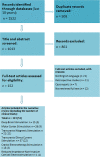Brain stimulation for chronic pain management: a narrative review of analgesic mechanisms and clinical evidence
- PMID: 37247036
- PMCID: PMC10227133
- DOI: 10.1007/s10143-023-02032-1
Brain stimulation for chronic pain management: a narrative review of analgesic mechanisms and clinical evidence
Abstract
Chronic pain constitutes one of the most common chronic complaints that people experience. According to the International Association for the Study of Pain, chronic pain is defined as pain that persists or recurs longer than 3 months. Chronic pain has a significant impact on individuals' well-being and psychosocial health and the economy of healthcare systems as well. Despite the availability of numerous therapeutic modalities, treatment of chronic pain can be challenging. Only about 30% of individuals with non-cancer chronic pain achieve improvement from standard pharmacological treatment. Therefore, numerous therapeutic approaches were proposed as a potential treatment for chronic pain including non-opioid pharmacological agents, nerve blocks, acupuncture, cannabidiol, stem cells, exosomes, and neurostimulation techniques. Although some neurostimulation methods such as spinal cord stimulation were successfully introduced into clinical practice as a therapy for chronic pain, the current evidence for brain stimulation efficacy in the treatment of chronic pain remains unclear. Hence, this narrative literature review aimed to give an up-to-date overview of brain stimulation methods, including deep brain stimulation, motor cortex stimulation, transcranial direct current stimulation, repetitive transcranial magnetic stimulation, cranial electrotherapy stimulation, and reduced impedance non-invasive cortical electrostimulation as a potential treatment for chronic pain.
Keywords: Chronic pain; Deep brain stimulation; Motor cortex stimulation; Non-invasive brain stimulation; Treatment.
© 2023. The Author(s).
Conflict of interest statement
The authors declare no competing interests.
Figures


References
-
- Treede RD, Rief W, Barke A, Aziz Q, Bennett MI, Benoliel R, Cohen M, Evers S, Finnerup NB, First MB, Giamberardino MA, Kaasa S, Kosek E, Lavand’homme P, Nicholas M, Perrot S, Scholz J, Schug S, Smith BH, Svensson P, JWS V, Wang SJ. A classification of chronic pain for ICD-11. Pain. 2015;156(6):1003–1007. doi: 10.1097/j.pain.0000000000000160. - DOI - PMC - PubMed
Publication types
MeSH terms
Substances
LinkOut - more resources
Full Text Sources
Medical

